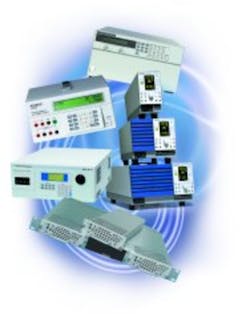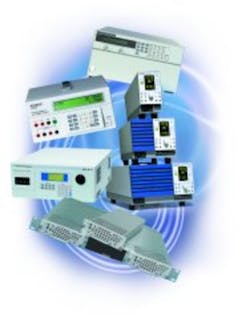Trends
A number of important legislative, economic, and technical trends are shaping the power supply market.
Control of Noise on Power Distribution Lines
IEC/EN 61000-3-2 in Europe and IEEE 519:1992 in the United States stipulate the upper limits on current harmonics allowed to be injected into the public AC distribution system. IEC/EN 61000-3-2 has replaced the older IEC 555-2 specification and applies to all AC-powered products that draw less than 16 A per phase.
Harmonics have increased because of the large, discontinuous current drawn by the capacitor-input power supplies commonly used in electronic equipment. At the same time, the use of electronic equipment sensitive to AC supply corruption also has increased, prompting the need for control of harmonic levels.
Many high-power DC supplies (Table 1) and AC sources (Table 2) meet the regulations by using active power factor correction (PFC) circuitry. This approach has largely replaced the line-frequency, inductor-input filters used many years ago when rectifiers were less robust and it was important to maintain large conduction angles.
Active PFC often is implemented as a switch-mode boost regulator with feedback to force the input current and voltage to be in phase. An inductor also is used in this design, but because it operates at the switching frequency of typically 100 kHz or higher, it is small and low cost.
This type of circuit provides several benefits in addition to near-unity power factor, a major one being an input voltage range from 80 to 270 VAC. The output of the boost regulator is a DC voltage somewhat higher than the maximum peak input voltage, about 400 VDC often chosen for inputs up to 270 Vrms. The important thing is that the input current and voltage are in phase, so power factors close to 1.0 can be guaranteed. The actual DC power supply or AC source circuitry runs from the 400-VDC PFC output.
Line regulation is a characteristic of high-power supplies that has changed as a consequence of active PFC. It really doesn’t make as much sense to talk about line regulation because most variation is removed by the PFC stage. The question is more one of holdup time in the event of a line dropout: How much local storage is provided by the supply? This specification is given in seconds or cycles and together with the value of the load current determines the size of the PFC output capacitor.
Higher Power Density
If you require several separate voltage or current sources in a test setup, the amount of space each supply takes is important. XANTREX recently introduced the XPD Series of programmable DC power supplies, claimed to have the highest power density available in the 500-W power range. Up to 540 W are available in a ¼-rack-width unit, which features both PFC and zero-voltage switching.
A Kepco application note explains how PFC increases the amount of power that a supply can produce, even though adding a PFC stage reduces overall efficiency.1 Harmonic current also is referred to as circulating current because it flows back and forth between the AC line and the power supply but does no useful work. PFC eliminates most of the circulating current, making it available to increase the output power.
“A switching converter with 80% efficiency and an uncorrected power factor of 0.65 can provide only 717 W of real power to a load [because it is limited to a maximum 12-A input current]. The maximum continuous rating of a standard 15-A branch circuit is 12 A. Equipping this power supply with PFC, despite lower conversion efficiency, allows it to use the full 12 A to produce real power for the load. With an overall efficiency of 67.5% the [power supply]…produces 932 W, an increase of 30%.”
Also helping to increase power density, by reducing power dissipation in a supply’s switching transistors, is so-called soft switching. Conventional switch-mode power supplies waste power during the switching transients. In the time the transistors take to turn on or off, significant voltage and current are simultaneously present, and the transistors must dissipate this power.
Soft switching, also called zero-voltage switching, commonly is part of a constant-frequency resonant switching scheme. “The parasitic output capacitance of the power transistors and the leakage inductance of the power transformer [form] a resonant circuit….An appropriate switching sequence allows the voltage across each transistor to swing to zero before the device turns on and current flows. Likewise, at turn-off, the voltage differential across the transistor swings to zero before it is driven to a nonconducting state.”2
The power saving may only be about 2%, but that’s 20 W in a 1,000-W supply. Because the losses take place in the switching transistors, already stressed just because of the application, mean time between failures (MTBFs) is improved. In addition, reduced switching transients mean that lower electrical noise initially is created, so supply EMI filtering will be more effective.
For its programmable switching regulator DC power supply, Elgar Sorensen’s Power Ten Division claims the highest power density in the 1-kW to 30-kW range. And California Instrument’s MX Series of programmable DC supplies provides as much as 45 kVA in a compact, floor-standing chassis with up to three units combined for a maximum of 135 kVA.
According to Elgar Sorensen’s Product Marketing Manager Robert Close, the most sought after DC supply features are low profiles and a compact design with minimum cooling requirements. High power density in a single unit does not mean that the same output load can be supported when several supplies are mounted close together in an equipment rack. This is the reason for the emphasis on minimum cooling specified for most manufacturer’s high-power products.
Fast Transient Response
“Digital communications devices draw rapid pulses of current that can cause significant voltage transients,” said Allison Harvey, a business development manager at Agilent Technologies. “These transients may trip your device’s low-voltage shutdown circuit and unexpectedly stop your test. The fast transient response of the Agilent 66321D Mobile Communications DC Source minimizes this problem.
“A proprietary power supply control-loop compensation design reduces sensitivity to wiring impedance and load lead lengths,” she explained, “so, it’s not necessary to use coaxial cables to connect to the DUT. One pair of ordinary twisted-pair wires for the power lead and one pair for the sense lead are all that’s required.”
The 66321D is specified to recover in <20 µs to within 20 mV of the final value after a 0.1-A to 1.5-A load change; maximum current is 3 A. With up to 15´ of 22 AWG wiring, the transient-caused voltage dip at the load typically is 40 mV.
Also intended for battery simulation in portable communications testing, the Keithley Model 2306 Battery/Charger Simulator provides <40-µs transient response under similar conditions; maximum current is 5 A. As a comparison, transient recovery times for low-cost, general-purpose power supplies typically are in the 1-ms to 2-ms range (Figure 1).
Supplies for Specific Applications
Keithley’s Robert Green, a senior market development manager, elaborated on the need for special-purpose power supplies. “In test and measurement, there is a trend toward sources designed for specific applications. These supplies are intended to increase test throughput, improve measurement accuracy, and simplify test-equipment integration. For many of today’s advanced products, this requires power sources that have exceptional bandwidth and stability for fast transient response and pulsed operation, with precise measurement of voltage and current.
“This is particularly true in the testing of wireless devices and laser diodes used in fiber-optic communications systems, which are very sensitive to transient overshoot, undershoot, and voltage droop,” he continued. “At worst, these phenomena can cause catastrophic damage to the DUT; in other cases, they may cause a false failure during functional testing. Rapid settling to a preset output voltage or currrent, without excessive overshoot or ringing, also improves test throughput.”
Mr. Green used fast transient response as an example of a power supply feature optimized for a particular application. He could just as well have chosen the programmable output impedance of the Agilent and Keithley supplies, intended to simulate battery resistance when testing mobile equipment.
Also supporting Mr. Green’s comments are many top-of-the-line AC power sources that include comprehensive arbitrary waveform generation and measurement capabilities. For example, consider the California Instruments’ MX45 and 500liX that provide high levels of DC, AC, or AC + DC power in single- or three-phase flavors.
In addition, predefined waveforms are available to simulate AC line and DC disturbances such as brownouts, drops, sags, surges, and sweeps. And by using the built-in arbitrary waveform generators (ARBs), you have the capability to develop and store as many as 200 custom waveforms to suit your application. A test program with up to 32 steps can be created to automatically apply a succession of transient waveforms. Measurements of the voltage and current for each phase are provided by a built-in digital signal processor (DSP)-based harmonics analyzer.
The MX45 has the further flexibility of accepting real-world waveforms downloaded from a digital oscilloscope in addition to those generated via the user interface or custom software. In this way, the equipment under test can be subjected to waveforms recorded in the actual operating environment.
Elgar’s SmartWave Series of AC power sources has similar specifications to those of California Instruments’ models, but at different power levels. Test programs of up to 100 segments are supported, each segment being defined by wave shape, amplitude, frequency, phase angle, and duration. If you really need to create separate waveforms for each of the three output phases, California Instruments and Elgar provide an independent ARB per phase.
Summary
As with most other types of test and measurement instruments, high-end power supply features will continue to migrate into mid-range products. A good example is the proliferation of the digital panel meter to the extent that any power supply with a measurement capability uses at least one. Similarly, PFC is becoming commonplace in supplies above 500 W to 1 kW. Remote programmability is available in many models of DC supplies selling for less than $500.
The temptation for a test manager is to future-proof test capabilities by buying a power supply with features that possibly may be needed sometime, but not today. In such a changing market, the opposite approach of buying only what you actually require may be the solution.
Power supply technology, including DSP-based measurement and analysis, is continuing to develop. It’s almost certain that if you can find the performance that you need today, tomorrow it will be available at a lower price, in a smaller box, and with more features.
References
- “Relationship Between Real Power, Apparent Power, and Power Factor,” Kepco Application Note, www.kepcopower.com
- “Programmable DC Power Supplies,” XANTREX Brochure, 2001, p. 36.
Return to EE Home Page
Published by EE-Evaluation Engineering
All contents © 2002 Nelson Publishing Inc.
No reprint, distribution, or reuse in any medium is permitted
without the express written consent of the publisher.
September 2002

